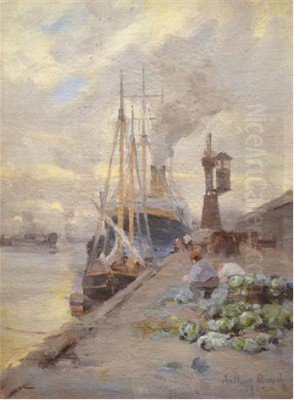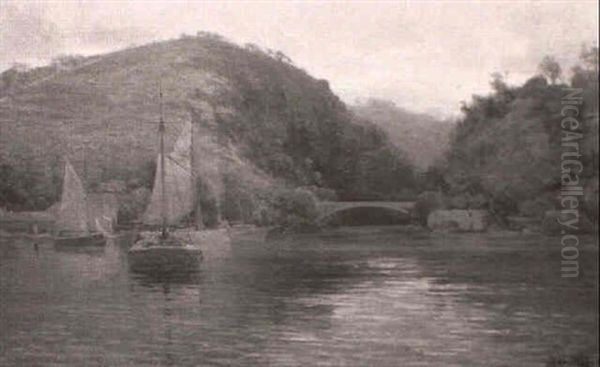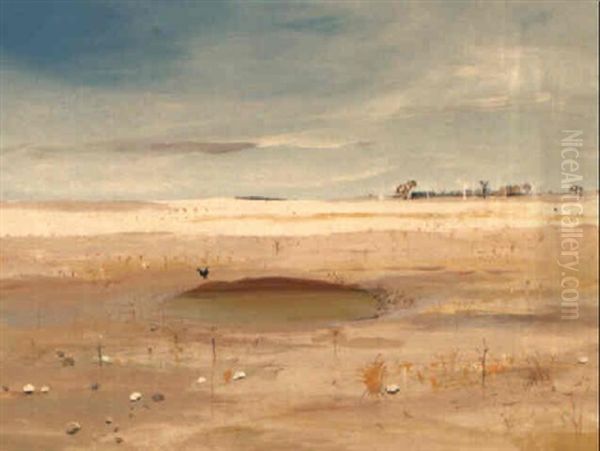
Arthur Merric Boyd stands as a significant figure in the landscape of Australian art, not only for his own contributions as a painter but also as the progenitor of one of the nation's most celebrated artistic dynasties. Born in 1862 in Opoho, Dunedin, New Zealand, and passing away in Murrumbeena, Victoria, Australia, in 1940, Boyd's life spanned a period of immense change and development in Australian culture. He was primarily a painter, known for his sensitive renderings of the Australian landscape, working proficiently in both watercolour and oils. His marriage to Emma Minnie à Beckett, herself a talented artist, established a partnership that would lay the foundation for generations of creative output.
Boyd's significance extends beyond his individual canvases; he and Emma Minnie fostered an environment where art was central to life, influencing their children and grandchildren who would go on to achieve national and international acclaim. Understanding Arthur Merric Boyd requires appreciating both his personal artistic vision and his foundational role within this remarkable family, whose collective work forms a vital thread in the fabric of Australian art history.
Early Life and Artistic Foundations
Arthur Merric Boyd's journey began not in Australia, but across the Tasman Sea in New Zealand. Born into a family with notable connections – his father was Captain John Theodore Thomas Boyd, and his mother Lucy Charlotte Martin – the family relocated to Australia during his youth. This move placed the young Boyd within the burgeoning cultural environment of Victoria. Details of his earliest formal art training are somewhat scarce, but it is evident that he developed his skills amidst the lively artistic milieu of Melbourne.

A pivotal moment in his life and career was his marriage in 1886 to Emma Minnie à Beckett. This union was significant not just personally, but artistically. Emma Minnie, known as Minnie, was an accomplished painter in her own right, hailing from a family with deep intellectual and artistic roots in Victoria – her father was William Arthur Callendar à Beckett. Together, Arthur Merric and Emma Minnie formed an artistic partnership, often painting alongside each other and sharing a deep appreciation for the visual world. Their shared passion created a uniquely stimulating household for their children.
Artistic Development and Style
Arthur Merric Boyd's artistic practice was firmly rooted in the traditions of landscape painting that were gaining prominence in Australia during the late 19th and early 20th centuries. While perhaps not as radical as some of his contemporaries associated with the Heidelberg School, his work shares their profound interest in capturing the unique qualities of the Australian light and environment. He worked extensively in both watercolour, noted for its immediacy and transparency, and oil paint, allowing for richer textures and tonal depth.
His style can be characterized as a form of lyrical Impressionism, focusing on the atmospheric effects and the subtle beauty of the natural world. He was a keen observer, translating the coastal scenery, rolling hills, and pastoral landscapes of Victoria onto canvas with sensitivity and skill. Unlike the more overtly nationalistic or heroic depictions sometimes found in the era, Boyd's work often possessed a quieter, more intimate quality. He engaged with the principles of plein air painting, capturing the fleeting moments of light and weather directly from nature, a practice championed by artists like Tom Roberts and Arthur Streeton.
Subjects and Themes
The Australian landscape was Arthur Merric Boyd's enduring subject. He found inspiration in the diverse scenery of Victoria, particularly the areas around Port Phillip Bay and the Yarra Valley. Coastal scenes, featuring beaches, cliffs, and the interplay of water and light, appear frequently in his oeuvre. Works like Portsea Pier exemplify his ability to capture the tranquil yet dynamic nature of the seaside environment. He was equally adept at depicting the rural hinterland, painting pastoral scenes, farmland, and the distinctive Australian bush.

An early and notable work, Sheds and Stables at the Grange, Harkaway (1889), provides insight into his connection to specific places and perhaps reflects the family's life at that time. Another documented work, Cataract Gorge, suggests his interest extended to capturing more dramatic natural features, likely depicting the famous Tasmanian landmark with attention to its geological forms and the flow of water. Throughout his work, the recurring theme is a deep engagement with place and a desire to convey the particular atmosphere and character of the Australian environment as he experienced it.
Exhibitions and Recognition
Throughout his career, Arthur Merric Boyd actively participated in the Australian art world, exhibiting his work regularly. He was a consistent presence in the exhibitions of the Victorian Artists Society (VAS) in Melbourne, a key institution for artists of the period. Showing work at the VAS placed him alongside many leading figures of Australian art, contributing to the vibrant dialogue and development of national painting styles. His contemporaries exhibiting at the VAS included figures like Frederick McCubbin and Walter Withers, leaders of the landscape movement.
Significantly, Boyd also sought recognition beyond Australian shores. His work was accepted for exhibition at the prestigious Royal Academy of Arts in London. Inclusion in the Royal Academy exhibitions was a mark of considerable achievement for colonial artists, indicating that his paintings met the standards of the British art establishment and offered a glimpse of Australian scenery to an international audience. This participation underscores his ambition and the quality of his output, positioning him as a professional artist engaged with both local and international art scenes.
A Family Immersed in Art
The home established by Arthur Merric Boyd and Emma Minnie à Beckett was not merely a domestic space but a crucible of creativity. Both parents were practising artists, and this immersion in art profoundly shaped their children. Art was not a distant profession but an integral part of daily life, discussed, practised, and valued. This environment proved exceptionally fertile, nurturing the talents of the next generation who would carry the Boyd name to even greater prominence.
Their children included William Merric Boyd (1888-1959), who became a pioneering figure in Australian studio pottery, known affectionately as Merric. Another son, Theodore Penleigh Boyd (1890-1923), emerged as a highly regarded landscape painter himself, whose promising career was tragically cut short by a car accident. Martin Boyd (1893-1972) achieved fame as a novelist, chronicling the lives of Anglo-Australian families often reminiscent of his own, his writing imbued with a strong visual sense. Their daughter, Helen à Beckett Boyd (1903-1999), also became a painter. This concentration of artistic talent within one family is extraordinary, and Arthur Merric and Emma Minnie were its vital source.
The Boyd Dynasty: Context and Continuation
Arthur Merric Boyd and Emma Minnie à Beckett stand as the foundational figures of arguably Australia's most famous artistic dynasty. While respected artists in their own right, their legacy is magnified by the achievements of their descendants. Their son Merric Boyd's innovations in pottery, often featuring Australian motifs and unique glazes, were groundbreaking. Merric and his wife Doris Boyd, also a potter and painter, continued the tradition of a creative household in Murrumbeena, which became a hub for artists.
This environment, in turn, nurtured their own children, Arthur Merric Boyd's grandchildren. The most famous of these is Arthur Boyd (1920-1999), an artist of international stature whose powerful, often symbolic paintings, ceramics, and prints explored themes of love, loss, war, and the Australian landscape. Other grandchildren also pursued artistic careers, including David Boyd (1924-2011), known for his paintings and pottery, and Guy Boyd (1923-1988), a prominent sculptor. The dynasty continued into subsequent generations, solidifying the Boyd family's unparalleled contribution to Australian arts and culture, all stemming from the initial partnership of Arthur Merric Boyd and Emma Minnie à Beckett.
Later Years and Legacy
Arthur Merric Boyd continued to paint throughout his life, remaining dedicated to his craft. He witnessed the burgeoning careers of his children, seeing the artistic passions he and Emma Minnie had nurtured come to fruition. He lived through a period of significant evolution in Australian art, from the nationalistic fervour of the Heidelberg School era to the beginnings of modernism. While his own style remained largely consistent with his impressionistic roots, he provided a stable foundation from which his descendants could explore new artistic territories.
He passed away in Murrumbeena in 1940, the Melbourne suburb that would become synonymous with the Boyd family's creative endeavours, largely through the activities of his son Merric and grandson Arthur. Arthur Merric Boyd's legacy is twofold. Firstly, he is remembered as a skilled and sensitive painter of the Australian landscape, contributing a distinct voice to the depiction of the nation's environment during a formative period. His works are held in various public collections, appreciated for their gentle beauty and atmospheric fidelity. Secondly, and perhaps more resonantly, he is honoured as the patriarch, alongside Emma Minnie, of the Boyd dynasty. Their commitment to art and their nurturing family environment unleashed a torrent of creativity that has profoundly enriched Australian culture for over a century. His influence is felt not just through his own canvases, but through the vast and varied artistic output of his children and grandchildren, including artists like his grandson Arthur Boyd, and contemporaries he exhibited alongside, such as Charles Conder and later landscape painters like Hans Heysen who continued the tradition of depicting the Australian scene.
Conclusion
Arthur Merric Boyd (1862-1940) occupies a unique and important place in Australian art history. As an artist, he dedicated his career to capturing the nuances of the Australian landscape, working with skill and sensitivity in watercolour and oils. His paintings offer valuable insights into the environment of Victoria in the late 19th and early 20th centuries, rendered with an appreciation for light and atmosphere characteristic of the era's landscape movement. His participation in major exhibitions both in Australia and London attests to his standing as a professional artist of his time.
Beyond his personal artistic achievements, Arthur Merric Boyd's enduring legacy is inextricably linked to his role as the founder, with his wife Emma Minnie à Beckett, of the Boyd artistic dynasty. Their shared passion for art created a family environment that fostered exceptional creativity across multiple generations and disciplines – painting, pottery, writing, and sculpture. While later Boyds, particularly his grandson Arthur Boyd, achieved greater international fame, Arthur Merric Boyd remains the crucial starting point, the patriarch whose life and work laid the groundwork for one of the most remarkable family contributions to Australian culture. He was both a painter of his time and place, and the wellspring of an artistic river that continues to flow.